Content
Published:
This is an archived release.
The Prosecution authority issued most sanctions
317 000 sanctions and close to 279 800 sanctioned persons were registered in 2012. The 26 800 persons sanctioned for crimes were 4.7 per cent fewer than the year before. Out of all sanctions in criminal cases, 58 per cent were issued by the Prosecution authority.
| 2012 | |
|---|---|
| All types of sanctions | 317 022 |
| All types of sanctions, on the spot fine not included | 76 783 |
| Sanctioned persons | 279 752 |
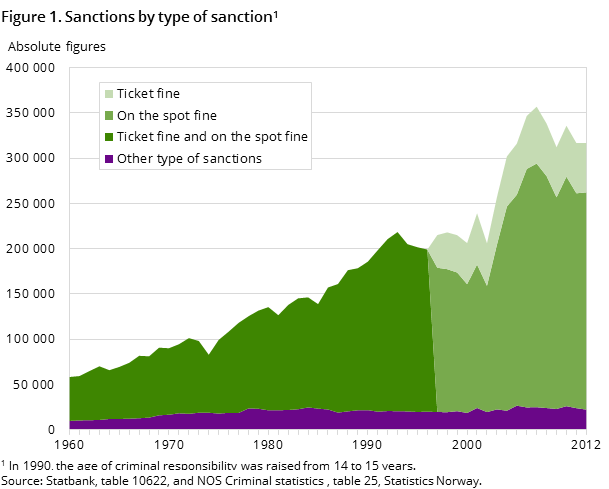
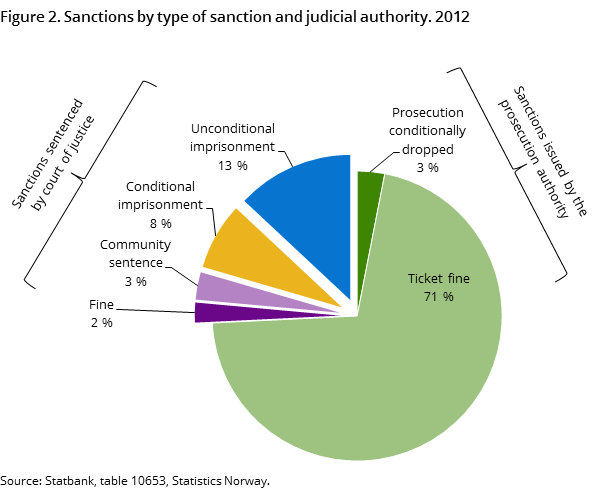
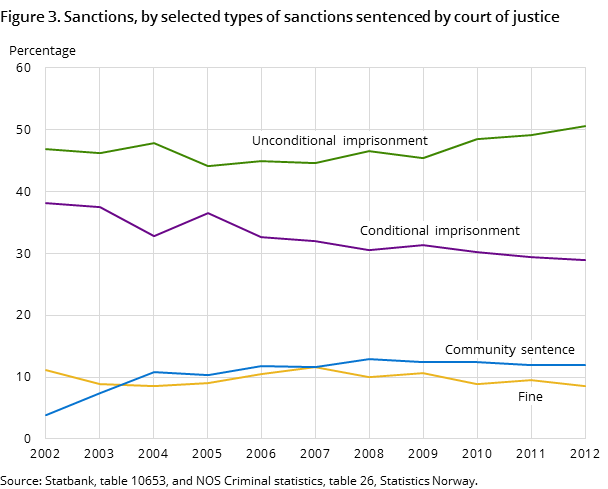
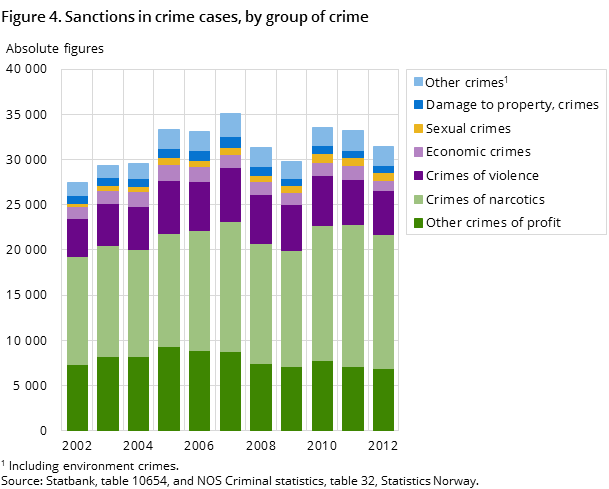
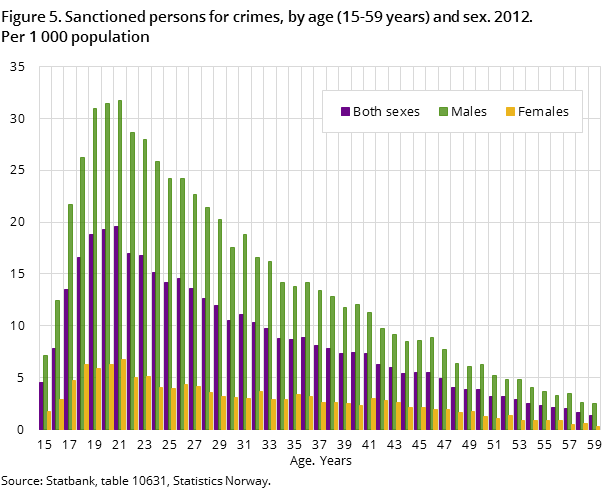
Of the 317 000 sanctions in total, 285 600 were misdemeanours and 31 400 were crimes. Compared to 2011, there were 1 900 more sanctions for misdemeanours, but almost a correspondingly large drop in sanctions for crimes. The total number of sanctions was approximately the same as in 2011. Relative to the population growth, 2011 and 2012 represents the lowest level of sanctions since 2003.
Three out of four sanctions are on the spot fines
In 2012, the total number of registered sanctions is dominated by the 247 500 sanctions for traffic misdemeanours as the principal offence . This is about the same number as in 2011, but lower than the average number of sanctions in the period 2006-2010. 90 per cent of the traffic misdemeanours were sanctioned by on the spot fines, mainly for illegal speed.
The police and the customs have authority to draw on the spot fines for less serious misdemeanours. As shown in figure 1, the total number of on the spot fines for traffic misdemeanours and misdemeanours against the duty act made up 76 per cent of all sanctions in 2012.
Less crime cases
As illustrated in figure 4, the number of sanctions in crime cases in 2012 was 5.3 per cent less than the year before. All groups of crime saw a drop in the number of sanctions, except sanctions for violent crimes as the principal offence, which was level in 2012 compared to 2011.
In numbers, sanctions for narcotic crimes as the principal offence saw the largest drop. In 2012, 14 750 sanctions were issued for this kind of crime, which was 900 less than the peak year of 2011, but still level with 2010. The 1 100 sanctions in 2012 with economic crimes as the principal offence were 30 per cent less than the year before, and to find correspondingly low levels of sanctions for economic crime, we have to go as far back as 1998.
Fewer fines and prosecutions conditionally dropped
The prosecution authority, represented by the police and the higher prosecution authority, can issue fines or prosecution can be conditionally dropped instead of commencing prosecution. In 2012, 54 600 ticket fines were issued, and 2 350 prosecutions were conditionally dropped.
Over the last decades, the frequency of these kinds of sanctions has changed significantly. From the 1980’s until the middle of the 2000’s, there was a massive increase in the use of ticket fines. After this peak period, the number of issued fines were somewhat reduced, and was further reduced by 1.7 per cent from 2011 to 2012. However, the number of prosecutions conditionally dropped saw a significant increase from the first part of the 2000’s and up to 2011. Nevertheless, in 2012 there were close to 14 per cent fewer sanctions were prosecutions were conditionally dropped, compared to the year before.
Thus, the prosecution authority still issue most sanctions of the judicial authorities, both in misdemeanour and crime cases. Not including on the spot fines, a total of 74 per cent of all sanctions were given by the prosecution authority, as shown in figure 2. As for sanctions for crime cases only, 58 per cent resulted in a fine or prosecution conditionally dropped.
Fewer sanctions pronounced by the courts
In 2012, 19 800 sanctions were given by the courts, which is 6 per cent less than in 2011, and more than 19 per cent less than the average number for the period 2001-2011.
Compared to the year before, there were drops in all types of sanctions given by the courts. Fines given by the courts and conditional imprisonment saw the largest drops, by 14 per cent and 7 per cent respectively. These types of sanctions also make out the largest declines since the middle of the 2000’s. The decline of conditional imprisonment has been most significant, and this type of sanction has been decreasingly used as a reaction for threats, assaults, larcenies, frauds and traffic misdemeanours, among other types of offences.
From the middle of the 2000’s and onwards, the number of unconditional imprisonments has varied. However, this type of sanction has not seen a drop like the one registered in conditional imprisonment – not in total, nor for the aforementioned types of offences. The difference in the development of these types of sanctions has altered the spread of type of sanctions, as shown in figure 3. Of all sanctioned pronounced by the courts in 2012, conditional imprisonment made up 29 per cent, while unconditional imprisonment made up 50.5 per cent. The corresponding shares from the middle of the 2000’s were 34 and 45.5 per cent.
Fewer unconditional imprisonments for narcotic crimes
In total, close to 10 000 unconditional imprisonment were sanctioned in 2012, which is 3.4 per cent less than the year before. Unconditional imprisonment for narcotic offences as the principal offence, mainly against the Penal Code, saw clearly the largest drop, with a decrease of as much as 16 per cent. However, by the principal offence, the number of unconditional imprisonments sanctioned for sexual offences, offences of violence and offences was somewhat larger than the year before.
Even if sanctions for traffic misdemeanours nearly always result in a fine, traffic misdemeanours also result in a considerable number of imprisonments in Norway . In 2012, a traffic misdemeanour was the principal offence in 21 per cent of all sentences with unconditional imprisonment. Driving under the influence of alcohol, or other drugs, was the principal reason in the majority of these cases. In total, there were nearly 3900 sanctions for driving under the influence in 2012. This is somewhat more than the year before, but still level with the historical low point registered in 2011. Unconditional imprisonment was the sanction in 44 per cent of all sentences for driving under the influence in 2012.
Some people given more than one sanction during the year
In 2012, close to 11 per cent of sanctioned persons were subject to more than one sanction, and sanctions were imposed on the younger part of the population more frequently than older age groups. Of all sanctioned men, 13 per cent had two or more sanctions, while the corresponding share for women was 7 per cent.
94,5 per cent residing in Norway
The new statistics for 2012 over sanctioned persons by citizenship show that 84.4 per cent of all sanctioned persons held a Norwegian citizenship, while the share for persons sanctioned for crimes was 78.7 per cent. The share of sanctioned persons holding a Norwegian citizenship varies significantly between the different groups of offence. For offences for profit, Norwegian citizenship holders made up 59 per cent. This relatively small share is partly due to offences against the Duty act, which makes up more than half of offences for profit, thus represented by a relatively large share of sanctioned persons holding a foreign citizenship. The share of persons with a Norwegian citizenship sanctioned for narcotic offences and offences of violence was 82 and 85 per cent respectively.
Out of all sanctioned persons with a known place of residence in 2012, 264 300 persons were registered as residing in Norway, and for crimes nearly 24 300 were residing in Norway. With that, 6.4 per cent of the population aged 15 years or over were registered as sanctioned for one or more offence in 2012, and the corresponding share for crimes were 0,6 per cent.
Many young men sanctioned
Nearly 10 per cent of the male population in Norway above the age of criminal responsibility was registered for one offence or more in 2012 (for more information on persons under the age of 15 years charged for offences, see Offences investigated ). The corresponding proportion for women was somewhat more than 3 per cent. Most of them, particularly the women, have committed less serious offences. For instance, only 1 per cent of men and 0.2 per cent of women residing in Norway were registered as sanctioned for one or more offence in 2012.
Young men are clearly overrepresented in the crime statistics on sanctions, as shown in figure 5. Men aged 19-21 years represent the largest proportion - more than 3 per cent. Out of all men sanctioned for crimes, 53 per cent were in the 17-30 year age interval.
The eldest most often sanctioned for misdemeanours
Out of the 253 000 persons sanctioned for misdemeanours – dominated by traffic misdemeanours and misdemeanours against the Duty act – as much as 57 per cent were in the age of 40 years or over. The same age group made up only 23 per cent of all persons sanctioned for crimes, but out of all persons sanctioned for sexual crime as their principal offence, 40 per cent were aged 40 years or older.
Expanded and adjusted statistics available in the StatBankOpen and readClose
This statistic now include more and more detailed tables with type of sanction, type of offence, age, sex and type of judicial authority. Additionally, there are more figures on sanctions by whether or not they are formerly registered in the Central Criminal Record. Also, statistics on sanctioned person now include citizenship. Compared to previously published statistics, there are made alterations in certain categories (for more details, se About the statistics). New statistics with figures for 2011 and 2012 are from this year on available in the StatBank. Further expansions will be assessed and supplemented, together with figures for earlier years.
New contents in data source for fines Open and readClose
The police have made significant changes in the method of registration into the Central registry for fines (BOT), which among other things renders possible more detailed information than before. The data Statistics Norway gathers from this registry, as one of three data basis for the statistics on Sanctions, are therefore changed and expanded from 2012 and onwards. This has caused changes in Statistics Norway’s handling of the data, as well as improvements in the scope, coverage and quality of the statistics (for more information, see About the statistics).
Contact
-
Sigmund Book Mohn
E-mail: sigmund.mohn@ssb.no
tel.: (+47) 94 32 77 22
-
Reid Jone Stene
E-mail: reid.jone.stene@ssb.no
tel.: (+47) 99 02 22 01
